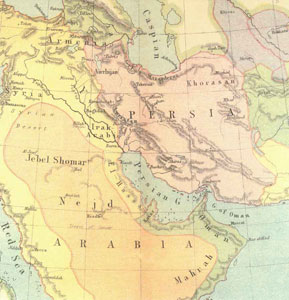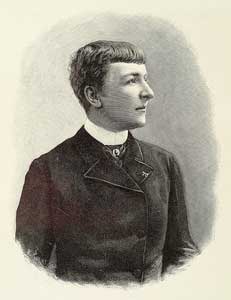| UCLA Library Special Collections |
 |
|
The Napoleonic
invasion of Egypt in 1798-99, and the 21-volume Description
de l’Egypte produced by his 167 researchers, ignited
the interest of Europeans in the whole Levant region. The
antiquities collected during the expedition (including the
Rosetta stone) were ceded to the British government in 1801.
In that same year, Sir Edward Daniel Clarke went to Palestine
to study archeology there; his student Johann Burckhardt then
traveled to the region in 1812, discovering the site of Petra
(and meeting Lady Hester Stanhope in Nazareth). As a result,
travelers (and pilgrims), increasing numbers of whom were
women, flooded these regions in the eighteenth and nineteenth
centuries seeking antiquities, lost cities and ruins. |

 |
|
|
 |
|
 |
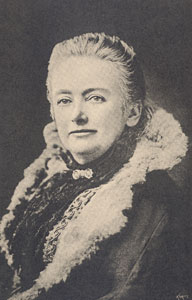 |
Amelia Edwards
(1831-1892) Edwards
made the popular journey up the Nile by dahabieh
(or flat-bottomed boat) recording, sketching and measuring
all the temples, monuments and artifacts she saw on the
way. A Thousand Miles was “the first general
archaeological survey of Egypt’s ruins.” (Robinson,
Wayward Women) Edwards founded the first Chair
in Egyptology (a science she helped to create) at University
College, London.
|
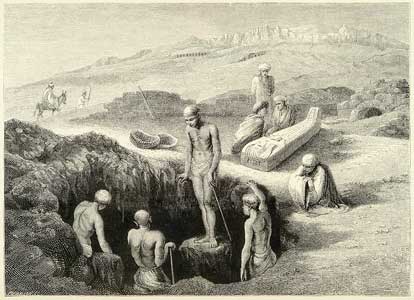
DIGGING FOR
MUMMIES. Wood engraving after a drawing
by Amelia Edwards, from A Thousand Miles up the Nile
(London: Longmans Green, 1877). |
| 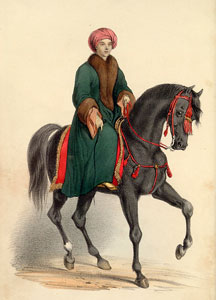
Frontispiece to
vol. 1 of Memoirs of the Lady Stanhope (London:
Henry Colburn, 1846). |
Lady
Hester Stanhope (1776-1839) Hester
Stanhope (niece of William Pitt) is one of the legendary
lady travelers. She sported Turkish men’s dress, wore
arms, and smoked a chibouk. She was the first woman to ride
unveiled into Damascus and the first western woman to enter
the forbidden city of Palmyra, where she claims to have
been crowned “Queen of the Desert,” under the
triumphal arch, by local Arabs.

|
LADY STANHOPE AT HER HOME
IN DJOÛN, A FORMER MONASTERY IN THE LEBANON MOUNTAINS.
|
| 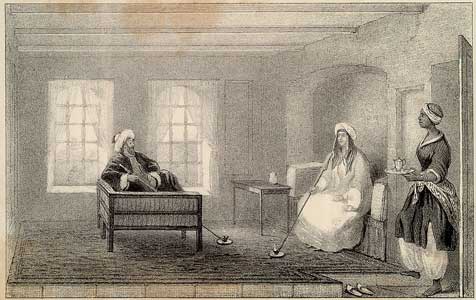
Frontispiece to
vol. 2. |
 |
VIEW OF THE ARCH
FROM THE WEST. |
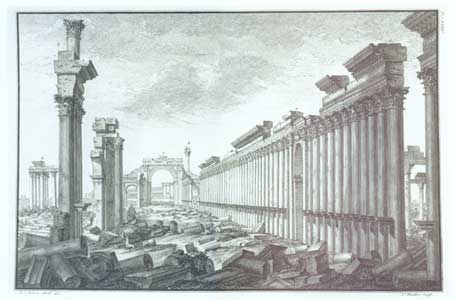
Engraving by Robert
Wood from The Ruins of Palmyra, otherwise Tedmor,
in the desart (London: 1753). |
|
Jane
Dieulafoy (1851-1916) |
|
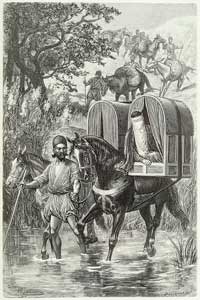
THE ROSE WATER MERCHANT’S
WIFE.
Engraving after a photograph by Jane Dieulafoy, from La
Perse, la Chaldée et la Susiane (Paris: Hachette,
1887). |
|
Dieulafoy
was only thirty when she and her husband Marcel (an engineer)
made lengthy, dangerous, expeditions deep into Persia measuring,
surveying and photographing sites for possible excavation.
At Susa, they discovered magnificent faiences, now in the
Louvre. Jane rode through Persia en cavalier, dressed as
a horseman. Since nineteenth-century French law made it
illegal for a woman to wear men’s clothing, she applied
for, and got, “permission de travestissement.”
(Hodgson, No Place for a Lady) |
JANE DIEULAFOY DEFENDING
HER EXPEDITIONS’ SUPPLIES DURING AN ATTACK BY BANDITS.
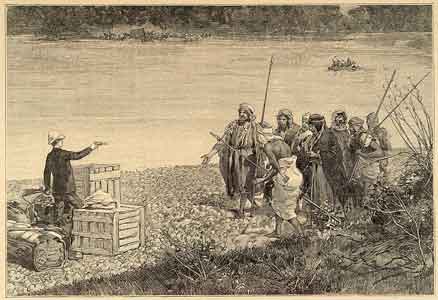
|
|
The original caption in Tour du Monde read: “I
have fourteen balls at your disposal; go find six more friends!”
|
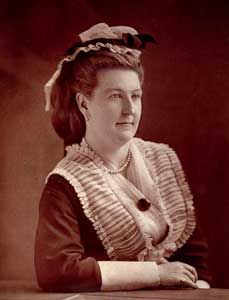
Frontispiece from
vol. 1 of Isabel Burton’s Inner Life of Syria,
Palestine and the Holy Land (London: Henry S. King
& Co., 1875) |
Isabel
Burton (1831-1896) Isabel
Burton married the swashbuckling African and Eastern explorer
Sir Richard Burton, and accompanied him on diplomatic postings
to Brazil and Syria. Inside Syria is about their
two years in Damascus, where he was British Vice-Consul
in 1870-71. “A bossy pair, they were nicknamed the
Emperor and Empress of Damascus.” (Blanch, Wilder
Shores of Love)
|
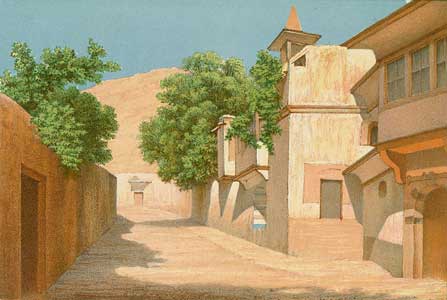
The Burtons’s
house in the village of Salahiyyeh, just outside of Damascus. |
| The
first volume of Richard Burton’s unexpurgated translation
of the Arabian Nights. Isabel, always uneasy with
her husband’s sensual side, gained notoriety when
she burned his diaries, and a translation of The Scented
Garden, after his death in 1890. |
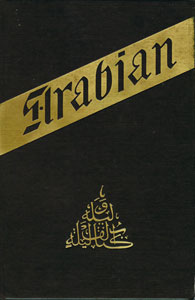
Richard Burton.
The Book of the Thousand Nights and a Night. Benares:
Printed by the Kamashastra Society, 1885. |
Richard
Burton
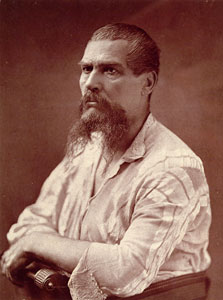
Frontispiece from
vol. 2 of Isabel Burton’s Inner Life of Syria,
Palestine and the Holy Land (London: Henry S. King
& Co., 1875) |
 |
| 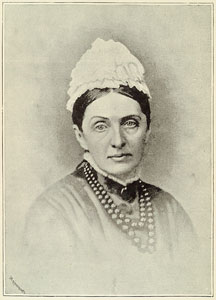
Frontispiece to
Isabella Bird’s Journey in Persia and Kurdistan
(New York: G.P. Putnam’s Sons, 1891) |
Isabella
Bird (1831-1904)
Bird is the “archetypal
Victorian Lady Traveler.” (Robinson, Wayward Women)
She began to travel the world at age forty. Wearing a specially
designed riding dress consisting of “full Turkish
trousers” (covered by an ankle-length skirt), and
holsters, she rode astride the saddle into some of the most
remote and physically challenging regions of Persia, China,
Tibet, Japan and Malaysia. She was the first woman to address
the Royal Geographic Society in 1892 and, in the same year,
one of the first women to be elected a Fellow of that Society.
|
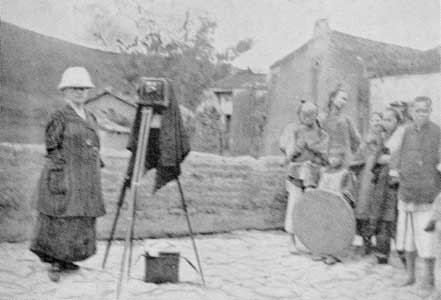
Miss Bird with her
camera. |
A group of
Armenian girls in a Bakhtiari village.
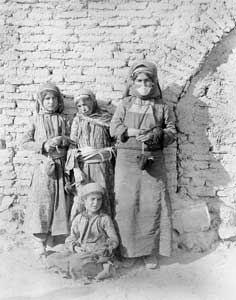
Photograph
by Isabella Bird.
|
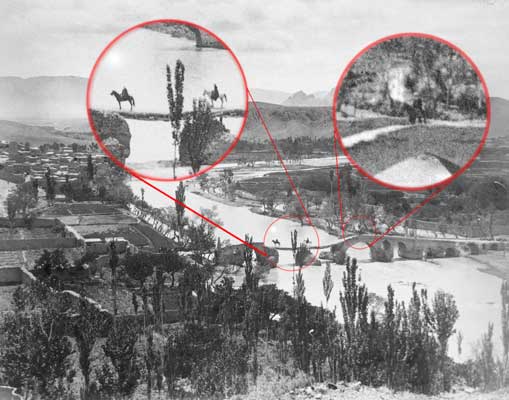
View of the Lenjan Valley,
province of Isfahan, Iran. (The three riders are Isabella
Bird, accompanied by the temporary escort of Miss
Bruce and Mr. Douglas, both “of Julfa.”)
|
|

wilder
shores exhibit home |
europe
| russia
| turkey
| the
middle east | india
and the far east | africa
| the
americas | credits
©
2007 by the Regents of the University of California. All rights
reserved. |
|
Wilder
Shores is organized geographically, loosely following the structure
of Barbara Hodgson’s book No Place for a Lady: Tales of Adventurous
Women Travelers. (Berkeley: Ten Speed Press, 2002). The exhibit features
books and manuscripts, both by and about, women who traveled to these
regions:
|
